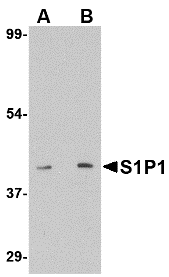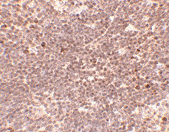Catalog# :4809
Movement of lymphocytes through lymphoid organs is required for generating immunity. Their migration into lymph nodes follows a series of events including integrin activation through chemokine signaling, adhesion and diapedis. The release of lymphocytes from lymph nodes is regulated by the phospholipid sphingosine-1-phosphate (S1P). One of its receptors S1P1 binds S1P with high specificity and affinity; agonism of this receptor by the immunosuppressive agent FTY720 inhibits the entry of tissue T cells into afferent lymphatics in homeostatic and inflammatory conditions. Recent experiments have indicated that CCR7-deficient T cells left lymph nodes more rapidly than wild-type cells did and these cells where also less effectively retained after treatment with FTY720, and that egress competence could be restored by inactivating G alpha i-protein-coupled receptor signaling. These results suggest that S1P1 acts in the lymphocyte to promote lymph node egress by overcoming retention signals mediated by CCR7 and G alpha i-protein-coupled receptor signaling. At least two isoforms of S1P1 are known to exist; this S1P1 antibody will only recognize the shorter isoform.
Additional Names : S1P1, Sphingosine-1-phosphate receptor 1, S1PR1, EDG1, ECGF1
 Description
DescriptionLeft: Western blot analysis of S1P1 in mouse thymus lysate with S1P1 antibody at (A) 1 and (B) 2 µg/ml.
Below:Immunohistochemistry of S1P1 in mouse thymus tissue with S1P1 antibody at 5 µg/ml.
Other Product Images
 Source :S1P1 antibody was raised against a 14 amino acid peptide near the carboxy terminus of the human S1P1.
Source :S1P1 antibody was raised against a 14 amino acid peptide near the carboxy terminus of the human S1P1.Purification : Affinity chromatography purified via peptide column
Clonality and Clone : This is a polyclonal antibody.
Host : S1P1 antibody was raised in rabbit.
Please use anti-rabbit secondary antibodies.
Application : S1P1 antibody can be used for detection of S1P1 by Western blot at 1 – 2 µg/ml.
Tested Application(s) : E, WB, IHC
Buffer : Antibody is supplied in PBS containing 0.02% sodium azide.
Blocking Peptide :Cat.No. 4809P - S1P1 Peptide
Long-Term Storage : S1P1 antibody can be stored at 4ºC, stable for one year. As with all antibodies care should be taken to avoid repeated freeze thaw cycles. Antibodies should not be exposed to prolonged high temperatures.
Positive Control :
1. Cat. No. 1409 - Mouse Thymus Tissue Lysate
Species Reactivity : H, M, R
GI Number : 13027636
Accession Number : NP_001391
Short Description : Sphingosine-1-phosphate receptor 1
References
1. Miyasaka M and Tanaka T. Lymphocyte tracking across high endothelial venules: dogmas and enigmas. Nat. Rev. Immunol. 2004; 3:360-70.
2. Mandala S, Hajdu R, Bergstrom J, et al. Alteration of lymphocyte tracking by sphingosine-1-phosphate receptor agonists. Science 2002; 296:346-9.
3. Ledgerwood LG, Lal G, Zhang N, et al. The sphingosine-1-phosphate receptor 1 causes tissue retention by inhibiting the entry of peripheral tissue T lymphocytes into afferent lymphatics. Nat. Immunol. 2008; 9:42-53.
4. Pham TH, Okada T, Matloubian M, et al. S1P1 receptor signaling overrides retention mediated by G alpha i-coupled receptors to promote T cell egress. Immunity 2008; 28:122-33.

No comments:
Post a Comment